April 2018 , in similar style to last month, started and finished with a wintry feel and some frosts and hill snow, but was, for the most part pretty warm and spring-like, with no extremes of weather, but... with temperatures ranging between -6c and +20c , the saying 'four seasons in one day' is not an exaggeration, and I would recommend anyone considering a future April visit to bring a good selection of varied clothing for all conditions!!
The days really are lengthening nicely now, with around 14 hours of usable daylight, but dawn (for the Black Grouse lek) is now a slightly less sociable 5am, and although many of the winter visiting birds had departed by mid-month, the (slightly late) influx of summer migrant birds north into this area from mid-month helped bird species day-lists creep ever higher, with 50+ species not uncommon on a full day local safari, or considerably more if you include a visit to the nearby Moray coast, whilst full day mammal species day-lists regularly crept up towards double figures, with early starts usually providing best results for the shyer ones.
 |
| Early morning at the foot of the Cairngorm Mountains |
To give you an idea of what you may realistically hope to see if you are planning a future April visit yourself, I hope the following more detailed information, illustrated with photos taken in and around the Cairngorms National Park by myself, my friends or my safari clients will help - clicking on the picture enlarges it to full screen.
Wildlife highlights included:
Local speciality and upland bird species seen regularly throughout the month included:
Black Grouse (pre-dawn start required), Red Grouse, Osprey, Ring Ouzel, Slavonian Grebe, Red-Throated Diver, Black-Throated Diver, Golden Plover and Goldeneye, with just a couple of brief glimpses of Crossbills. Capercaillie, despite several dawn walks in suitable forest habitat ,sadly, proved to be very elusive, and It should also be noted that, due to their very secretive nature at this time , Crested Tits also become extremely difficult to see during breeding season (April-May), and we struggled to see them after mid-month..Snow Buntings were seen at low level sites early in the month, but seemed to have retreated high up to the mountain tops, as the snow line receded...where Ptarmigan were also reported once the snowsports activity had 'calmed-down' .....
Winter visiting birds were represented by a few remaining family groups of Whooper Swans, flocks of Greylag Geese, wildfowl such as Wigeon and Teal, and a few Redwings , Fieldfares, Redpolls and Bramblings lingered....
Summer migrant birds flooded in from mid-month, with our first sightings this year of Common Sandpiper, Sand Martin, House Martin, Swallow, Willow Warbler, Chiffchaff, Wood Warbler, and Tree Pipit to name just a few...
Mammals seen regularly by my safari parties during the month included:
Rabbit, Red Squirrel, Roe Deer, Red Deer, Sika Deer, Reindeer, Feral Mountain Goat (with youngsters), Brown Hare and Mountain Hare (now a mottled bluey-grey), with just a couple of brief glimpses of Stoats and black Water Vole.
April bird sightings:
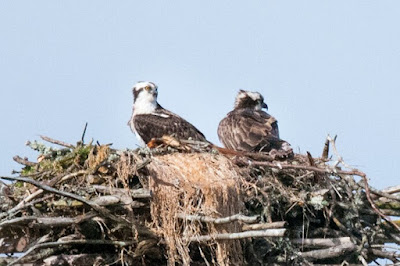 |
| Ospreys by Andrew Palmer |
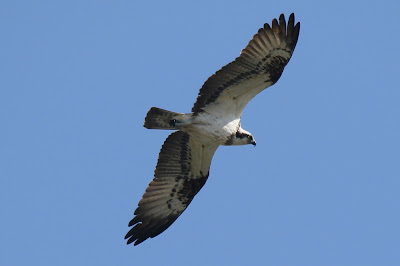 |
Osprey by Steve Nicklin
|
One of my favourite wildlife moments every year, is the return of our local Ospreys to their nesting sites. These impressive birds of prey are always popular with my safari clients, with their dashing good looks, large size, aerial acrobatics and spectacular plunge diving to catch fish. My favourite local pair were reunited mid-month after a winter apart in West Africa, and were soon seen building up the nest, chasing off intruders and mating frequently,and by the very end of the month the hen bird appeared to be incubating eggs as the cock bird began to perform all of the fishing duties, whilst she stoically brooded the eggs despite the sometimes wintry weather.
 |
| Lekking Black Grouse ( pic taken from a hide) |
April is definitely THE month to see Black Grouse, and dawn (now around 5am) visits to local Black Grouse leks continued to delight and amaze my safari clients with as many as 6 blue-black cock birds seen 'performing' in very aggressive fashion, their incredible bubbling and whooshing sounds drifting across the moor, and on a couple of occasions we were very lucky to witness (up to 10) hen birds watching the action, presumably 'rating' the contestants, and some were even seen mating with their chosen partner - a truly fantastic wildlife spectacle and a great way to start the day!
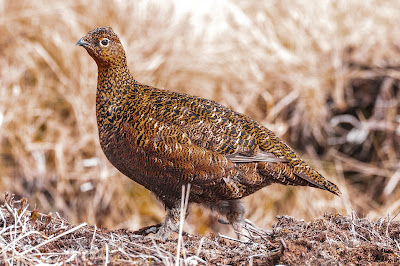 |
| Hen Red Grouse by Andrew Palmer |
 |
Cock Red Grouse
|
Our local moorlands continued to echo with the characteristic cackling calls of the cock Red Grouse, many of whom were seen still actively displaying from raised positions, with red 'eyebrows' aglow, presumably 'guarding' their territory, and from mid-month we saw very few hen birds, suggesting that many may already be incubating eggs.....
With no 'rogue' birds in this area to go for these days, and numbers now confirmed to be declining to dangerously low levels, Capercaillie sightings are now much more difficult to come by, and sadly, we only managed one brief sighting of a female bird this month, despite several dawn walks in suitable habitat, where we had been successful before...
Crested Tit sightings too were few and far between this month, with one or two birds seen using forest feeding stations during the colder weather, but generally they were pretty elusive, seemingly quietly going about their business breeding.....
 |
| Female Crossbill by Steve Nicklin |
Still in the forests, sadly, it was the same old story with our Crossbill sightings , most of which were of the rather annoying fly-over variety again this month, though those of us quick enough with our binoculars, and alerted to them by their distinctive 'jip' 'jip' calls, saw enough to suggest that we were seeing family groups of streakily marked youngsters with their parents....
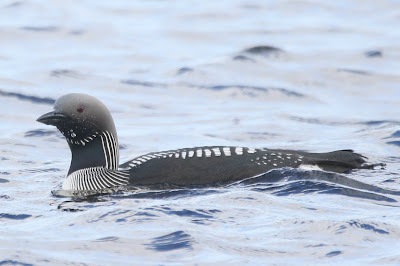 |
| Black-Throated Diver by Steve Nicklin |
 |
| Slavonian (Horned) Grebe |
Now the local lochs are no longer in danger of freezing over, some of our local speciality water birds are back on their summer breeding territories, and we managed to see some of the most attractive and rare examples regularly this month - namely Slavonian (Horned) Grebe, Red-Throated Diver and Black-Throated Diver, all in their splendid summer plumage.
 |
| Dippers by Steve Nicklin |
On the rivers, it was noticeable that there were increased occurrences of male Dippers seemingly delivering food to the now well hidden female birds at their nest sites , usually under bridges or under high , overhanging banks...and also a few instances of rival males fighting over territory...
 |
| Male Ptarmigan by Steve Nicklin |
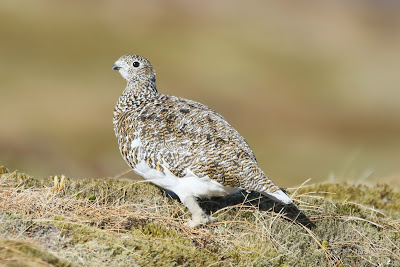 |
| Female Ptarmigan by Steve Nicklin |
 |
| Snow Bunting by Andrew Palmer |
Up in the mountains, as I mentioned earlier, although I did not make a trip up to the the tops myself this month, once the snow sports activity had died down sufficiently, those that did ,reported some decent sightings of Ptarmigan and Snow Bunting, both now morphing into their summer plumage...
 |
| Male Ring Ouzel by Andrew Palmer |
At slightly lower levels, Ring Ouzels proved to be popular with my safari clients, presumably because not many will have seen them, as they tend to breed only in remote upland areas well away from human disturbance, and can be quite tricky to find. We are fortunate in having plenty of suitable habitat for them in this area though, and we were able to get decent views and photographs of both male and female birds on a number of occasions.
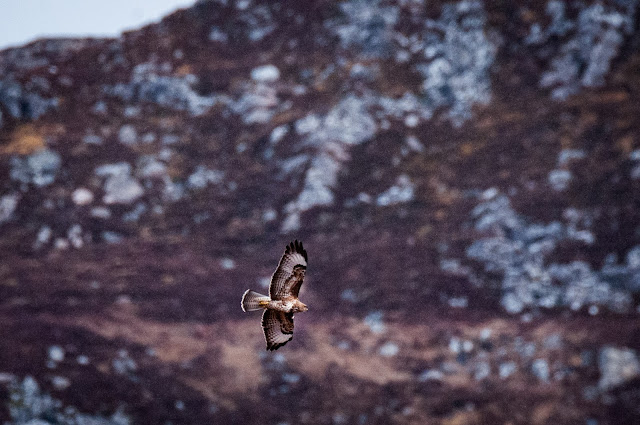 |
| Soaring Common Buzzard by Andrew Palmer |
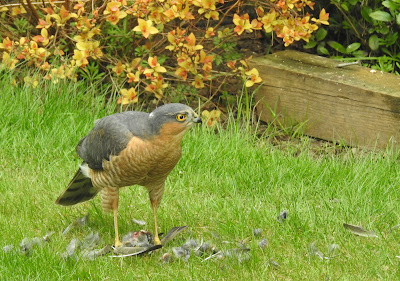 |
| Male Sparrowhawk with prey |
Bird of prey sightings usually become less frequent during the longer days of spring and early summer, with many of the female birds now nesting and many more hours of daylight available for hunting, and so it proved this month. However, we still managed regular sightings of Osprey, Common Buzzard, Red Kite, Peregrine, Kestrel and Sparrowhawk, just a few views of Goshawk, Golden Eagle and White-Tailed Eagle, and one brief glimpse each of Short-Eared Owl and Merlin...
 |
| Redshank |
 |
| Golden Plover by Steve Nicklin |
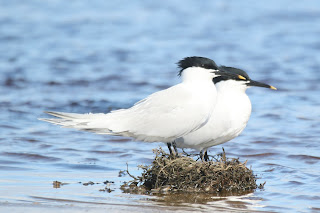 |
| Sandwich Terns by Steve Nicklin |
The Moray coast is only about 40 miles North East of Aviemore, and although I did not have time for a trip myself this month, it would appear that the areas reserves, salt marshes, lochs, bays and harbours gave good views of
Divers,
Eiders,
Greylag Geese,
Pink-Footed Geese,
Whooper Swan,
Wigeon,
Teal,
Pintail,
Bar-Tailed Godwit,
Knot, Golden Plover ,
Grey Plover , Ringed Plover , Guillemot, Black Guillemot, Whimbrel and
Long-Tailed Duck .....and as the month progressed 'summer' birds such as
Auks,
Terns and
Skuas ...suggesting that this is an area worth considering visiting when staying on Speyside..
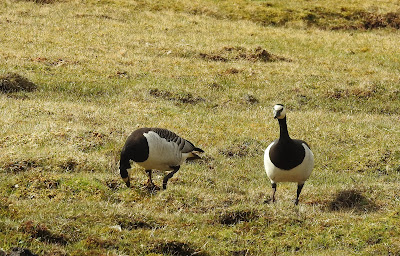 |
| Barnacle Geese |
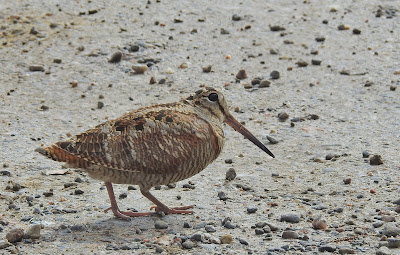 |
| Woodcock |
Other 'good' or unusual birds reported locally this month included
Greenshank,
Brambling,
Woodcock,
Barnacle Goose,
Nuthatch ,
Hawfinch and
Mandarin Duck .....
April mammal sightings:
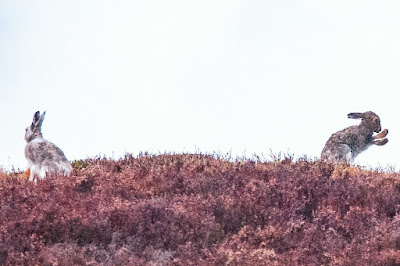 |
| Mountain Hares by Andrew Palmer |
Mountain Hare was voted 'mammal of the day' most frequently this month. Despite them now being in their mottled white and blue-grey spring coats, they were often a 'life tick' for many of my safari clients, not surprising I suppose, when you consider that they are only found in a very few areas of the UK...
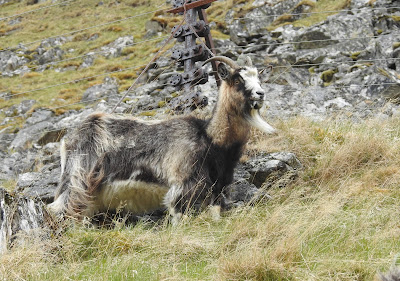 |
| Feral Mountain Goat |
Feral Mountain Goats too are only found in a few remote upland areas of the UK, and we were lucky enough to have many good views of these wild looking, multi-coloured creatures, with the youngsters now almost as big as the adults...
 |
| Red Squirrel |
Red Squirrels too, are very localised in the UK, but we managed at least one, and often several sightings on every safari this month, including seeing some very entertaining high speed chases round tree trunks at forest feeding stations.
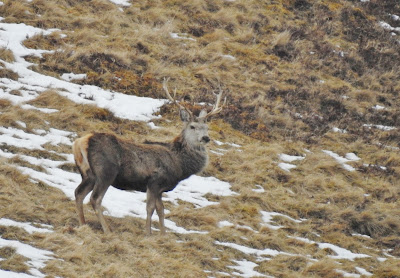 |
| Red Deer stag |
Red Deer too, always prove popular with my safari clients. Being an iconic animal of the Scottish Highlands, they are on most visitors 'wish-lists', and we managed to see them regularly in large same-sex herds in upland glens this month, though many of the stags are now losing their antlers....
Roe Deer however, are common and numerous over most of the UK, but due to their nervous nature and crepuscular habits, they are rarely seen well unless you are out and about early or late...
 |
| Sika Deer |
Sika Deer were encountered frequently on my safaris this month, with many of my clients seeing them for the first time. For those not familiar with this species, they originate from Asia and were introduced into the UK in the late 19th century, and are mostly to be found on large country estates...
 |
| Brown Hare by Steve Nicklin |
Brown Hares were witnessed 'boxing' and friskily chasing around this month in suitable habitat, with early mornings proving to be most successful for sightings...
We also saw our first few brave Butterflies this month, as well as numerous Frogs and Toads ......
So, to summarise....It is only when I finally find time to sit down and compile my monthly wildlife sightings blog and look back through the photos that I and my safari clients have taken during the month that I really become aware of what a great time I have had, appreciate how lucky I am to live and work in such a wild and beautiful place, and spend time out and about sharing it with other like-minded wildlife fans, .... and it would appear that April 2018, despite the sometimes wintry weather, turned out to be a really excellent and very enjoyable month for wildlife watching in and around the Cairngorms National Park (and beyond!), With the local speciality birds displaying and singing, the returning summer visiting birds flooding northwards to join our resident species, the days lengthening, flowers (finally!) blooming, the stunning scenery and the weather ( generally! ) improving, I can honestly say that I would not want to be anywhere else in the world than here in the majestic Scottish Highlands at this time of year....
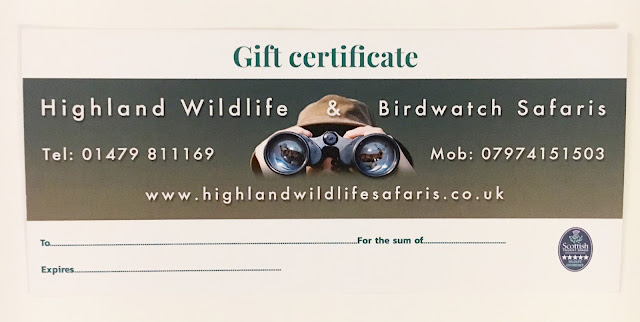
If you think you know someone who may enjoy a taste of what I do, why not treat them to a safari gift certificate. They make a thoughtful and imaginative present, are available for any amount and are valid at any time within a year from date of purchase....
 |
| The Spey Valley hidden under low cloud - as seen from Cairngorm Mountain |
















No comments:
Post a Comment